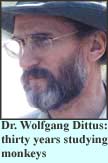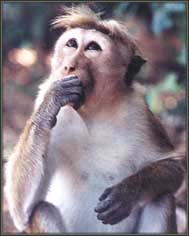 |
 1st August 1999 |
Front Page| |
No business like monkey businessIn the forest around the Polonnaruwa archaeological reserve, a group of wildlife enthusiasts headed by Dr. Wolfgang Dittus has been engaged in a study of primates whose sophisticated social behaviour is akin to those of human beings.
Wolfgang Dittus first came to Sri Lanka in 1968 as a graduate student, attached to a Smithsonian biological programme. After the programme closed down, he started research on monkeys for his PhD, applying for funding from various organisations. "What we are doing is basic research primarily to find out what monkeys are all about," said Dr. Dittus, who is now attached to the Sri Lanka Institute of Fundamental Studies (IFS). The IFS got involved in the programme in 1982. Funding is obtained through the US National Science Foundation, the Smithsonian Institute and other agencies that support zoological research. Dr. Dittus and his Monkey Camp, as the research centre is commonly referred to, is well known in the area. To reach the camp, one has to drive into the forest where the living quarters and small research centre are found in a beautiful location, near the tank. Dr. Dittus lives at the camp for long periods though he also has an office in Kandy. His wife Viji and five-year-old son Thomas join him at the camp during the school vacations. "Monkeys have a sophisticated form of social behaviour," Dr. Dittus said. "Many parallels can be found to human behaviour." They live in social groups, classified as high-ranking and low-ranking groups. In the area covered by his research, there are 32 such groups or villages with a population of over 1000 monkeys. Four types of monkeys are seen in the area-the Macaque locally known as Rilawa, the Grey Langur or Wandura, the Purple Faced Langur or Kalu Wandura and the Loris which is a small nocturnal variety. Work begins early at the research centre with breakfast at 4.45 a.m., after which the researchers go to the field. The field assistants know each monkey, recognising them by the colour of face, markings, spots, pigment on lips and so on. "Each one is an individual and has been given a name," Dr. Dittus said. Identity cards are maintained for each monkey, giving name, group, class, age, sex and date of birth if known. The identity card also bears a sketch of the monkey's facial markings and describes identifying features such as pelage (fur), configuration of hairstyle which varies, face colour, ears, pigmentation, colour of skin on the underside and other special features. "When we follow monkeys, we chart their movements on a map indicating the geographical features of the land. Following them on a daily basis, helps to identify how the monkeys use the land. Each group has a range of about 16 - 20 hectares, which sometimes overlap. Disputes arise over land, trees, resting places and waterholes. When two groups come together at a waterhole, the dominant group chases the other away," Dr. Dittus said. Research has shown that monkeys have a strong ranking system which exists at three levels, within a family, between different families and between groups or villages. The higher-ranking monkeys dominate the lower-rankers, who get used to being harassed and learn to be subordinate. In a village, you will find the grandmothers, mothers and daughters. At adolescence, the males migrate to other villages or are rejected to prevent incest or inbreeding. The male monkeys in a village are those who have come from outside and are not related. When it comes to reproduction, the females are selective. The higher-ranking females reproduce more than the lower-ranking ones since they have access to better food and resting places. Sometimes, young females challenge the establishment. The high- ranking groups are then thrown out and have to look for other places. "The infant mortality in monkeys is high," Dr. Dittus said. "As they grow older, life expectancy increases. The average life expectancy, taking into account the high infant mortality rate, is around six years. If the female survives to reach adulthood and reproductive age, which is six years, she could expect to live another 15 years."
Research on diseases that affect the monkeys is also carried out at the centre. "Monkeys are subject to Dengue," Dr. Dittus said, citing a wave of the dread disease in 1987. They are also affected by Malaria, worms, and intestinal parasites. There have been no signs of AIDS in these monkeys. The monkeys tend to change their sleeping places to prevent infection from worms and such diseases. Observing a group of monkeys in the forest close to the archaelogical sites, a grandmother, mother and daughter were identified by the field assistants. Dr. Dittus said the fathers cannot be identified easily. The only method for positive identification is by genetic finger printing. Blood samples have to be taken and sent for testing to specialized laboratories with trained technicians. For this testing, the blood is taken from the monkeys while in the forest. Five-year-old Thomas, Dittus' son who appeared to be well versed in monkey lore, detailed the process involved. "First the monkey is trapped and weighed," he said. "Then cleaned with an alcohol swab. They take an injection and draw blood. A cotton swab is held at point of injection. The name of the monkey is written on the vial and the blood placed in a cooler box. Then Daddy and his assistants measure the monkey. Sumith tattoos the monkey and Saline is given to it before it is released." Sunil Gunatilleke, research coordinator, has worked on the project for 15 years. "My main duty is to identify individual monkeys and maintain records of population. A monthly census is held for each group. A list of individual monkeys in each group is entered in a book. Once a month, the field assistants visit the groups and identify the monkeys to verify whether all are present. Whenever there is a pregnant female, we go once in five days and check on its condition," Sunil said. Sunil says they also do dominancy tests to determine the social rankings of the troupes. A hierarchical order of 1st, 2nd,or 3rd rank is thereby determined. Monitoring is done to see whether the top-rankers remain on top or come down in rank. "I love this work," Sunil remarked. "They are not just monkeys to me now. They have become like family. We have our favourites and they know us."
Spreading a clean messageThe Clean Reserves Project was established in the Polonnaruwa archaeological reserve on August 1 last year. The aim of the project is to keep the sanctuary clean. "We try to prevent people from throwing litter in the archaeological reserve and the jungle," said Dr. Wolfgang Dittus, who initiated the project. Funding for the project is from the Central Cultural Fund. A large number of tourists both local and foreign visit Polonnaruwa to see the ancient ruined city. On a peak week-end, there are around 10,000-12,000 visitors. The foreign tourists do not litter much but locals who come, picnic on the site, light fires, cook and litter the place with remnants of food and plastic bags. The Clean Reserves Project was launched with a small group comprising mostly youth from the area. At the entrance to the sanctuary, a few young people have been trained to speak to the visitors politely and request them not to litter the area. Within the sanctuary, and in the restaurant areas, dustbins have been placed for the garbage. Some of the project workers go round monitoring picnic parties and encouraging them to put their litter in the bins provided. Eye-catching signboards carrying the message in English and Sinhala, have been put up along the roads in the sanctuary. A tractor goes round twice daily to collect the garbage from the bins. Monitors also move around in the restaurant area. Dr. Dittus said a plot of land has been given by the Central Environmental Authority for the project. "We collect some refuse and recycle it. Some things like discarded king coconut shells, we cut up and distribute for fuel. We compost the other garbage. We have a programme with the Forest Department for a plant nursery," Dr. Dittus said. Samera, a young boy from Polonnaruwa had passed his A'Ls and was unemployed when he joined the Clean Reserves Project. "I work at the gate requesting visitors very politely, to refrain from littering the place," Samera said. "Four or five of us work at the gate and the rest monitor the area within the sanctuary while two drive the tractor. When garbage is found, we collect it by tractor. We find that there is much less garbage thrown about after the project was started." Dr. Dittus said more concrete bins, that were monkey proof were being made. Visitors are also advised to avoid feeding the wild life. With more volunteers from the area hopefully being enlisted to pass on the message, they have plans to gradually extend the scope of the project. |
||
 |
Front Page| News/Comment| Editorial/Opinion| Business| Sports | Mirror Magazine |
|
 |
Please send your comments and suggestions on this web site to |
|
 Monkeys
are every where in the forests around the Polonnaruwa archaelogical reserve.
Swinging on trees, scratching for food in the soil, there are big and small
ones, some gray, others with red faces. Living in their natural habitat,
is Dr. Wolfgang Dittus, who together with a small team of field assistants,
has closely observed monkeys and their social behaviour, for over 30 years.
Monkeys
are every where in the forests around the Polonnaruwa archaelogical reserve.
Swinging on trees, scratching for food in the soil, there are big and small
ones, some gray, others with red faces. Living in their natural habitat,
is Dr. Wolfgang Dittus, who together with a small team of field assistants,
has closely observed monkeys and their social behaviour, for over 30 years. Dr.
Dittus explained that monkeys have special warning calls and signals against
predators when they go in search of food. From these alarm calls, the monkeys
know how to respond through appropriate protective action. For example
if a python is sighted, they chase it away or avoid it. If a Raptor call
is heard, the monkeys immediately drop to the ground.
Dr.
Dittus explained that monkeys have special warning calls and signals against
predators when they go in search of food. From these alarm calls, the monkeys
know how to respond through appropriate protective action. For example
if a python is sighted, they chase it away or avoid it. If a Raptor call
is heard, the monkeys immediately drop to the ground.